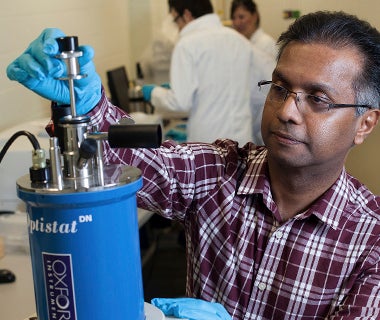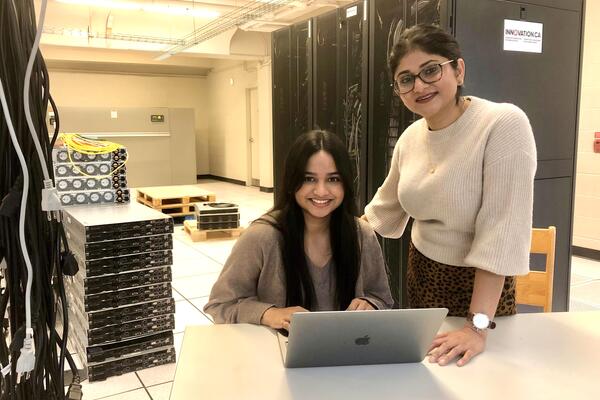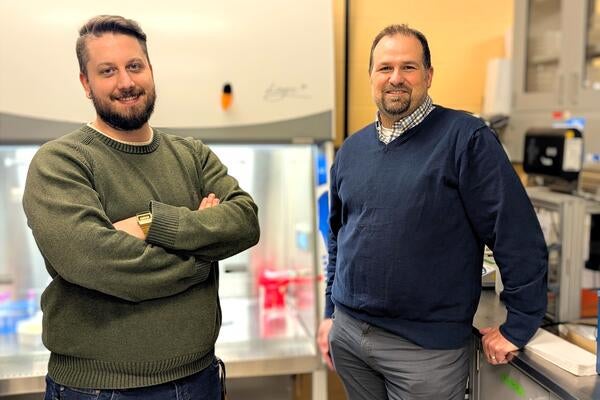
Solar panels that are good for the environment and for people
As green energy technologies become mainstream, a Waterloo researcher is making sure our health and safety is considered from “desktop to rooftop.”

As green energy technologies become mainstream, a Waterloo researcher is making sure our health and safety is considered from “desktop to rooftop.”
By Beth Gallagher Communications and Public AffairsAs researchers design the next generation of solar panels with nanomaterials, Siva Sivoththaman is already looking 10 years ahead: He’s thinking about how the new, nano-enabled technologies will be safely deployed.
Sivoththaman, a professor in the Department of Electrical and Computer Engineering, says he looks at emerging technologies through a health and safety lens so that a full picture can be considered early on.
 Siva Sivoththaman, director of CAPDS
Siva Sivoththaman, director of CAPDS
“When we start to experiment with new material, we need to be mindful of how it will be manufactured safely and how it can be recycled at the end of its life,” says Sivoththaman, the director of the Centre for Advanced Photovoltaic Devices and Systems (CAPDS).
Sivoththaman says considering health and safety effects at the very earliest stages of research actually provides researchers with new challenges that ultimately give green energy technologies a solid place in society’s future.
“We don’t just study things and walk away,” says Sivoththaman. “We study and provide solutions. It’s about taking precautions rather than shutting it down altogether.”
Sivoththaman envisions green manufacturing facilities of the future with tight controls that protect personnel working with nanomaterial. Airborne nanoparticles can pose serious health risks through inhalation and dermal exposure.
Wind power
While potential health effects of wind turbines is another key aspect researched by his collaborators from Waterloo’s School of Public Health and Health Systems, Sivoththaman is also addressing safety concerns. His team of researchers is developing sensors that can predict structural issues in wind turbines.
“These turbines are huge; they are well over 100 metres in diameter. Obviously, any structural failure is a safety risk,” says Sivoththaman. The advanced sensors will detect any strain on the structure and act as early warning devices.
Clean power
As renewable energy sources become more widely used and increasingly tied to the electrical grid, researchers like Sivoththaman will be monitoring the sources to make sure the new power is properly “conditioned” to be seamlessly and safely delivered to the grid.
It’s all part of making sure the emerging green energy technologies provide society with clean energy for years to come. “If you don’t take precautions now you are going to have problems,” says Sivoththaman who is also the Ontario Research Chair in Renewable Energy Technologies and Health.

Engineering master's student Nayeema Nonta (left), one of the three paper authors, and her supervisor, Dr. Sirisha Rambhatla, in a large server room with the computer power needed to develop their new LLM training technique. (University of Waterloo)
Read more
Waterloo researchers develop highly efficient AI training system that paves the way for cheaper, greener “intelligent partners”

Read more
Engineering researchers team up to tackle the plastics pollution problem with microbial innovation and engineering design

Read more
15 University of Waterloo researchers have been named to the annual Highly Cited Researchers™ list for significant contributions to their specific fields of research
The University of Waterloo acknowledges that much of our work takes place on the traditional territory of the Neutral, Anishinaabeg, and Haudenosaunee peoples. Our main campus is situated on the Haldimand Tract, the land granted to the Six Nations that includes six miles on each side of the Grand River. Our active work toward reconciliation takes place across our campuses through research, learning, teaching, and community building, and is co-ordinated within the Office of Indigenous Relations.